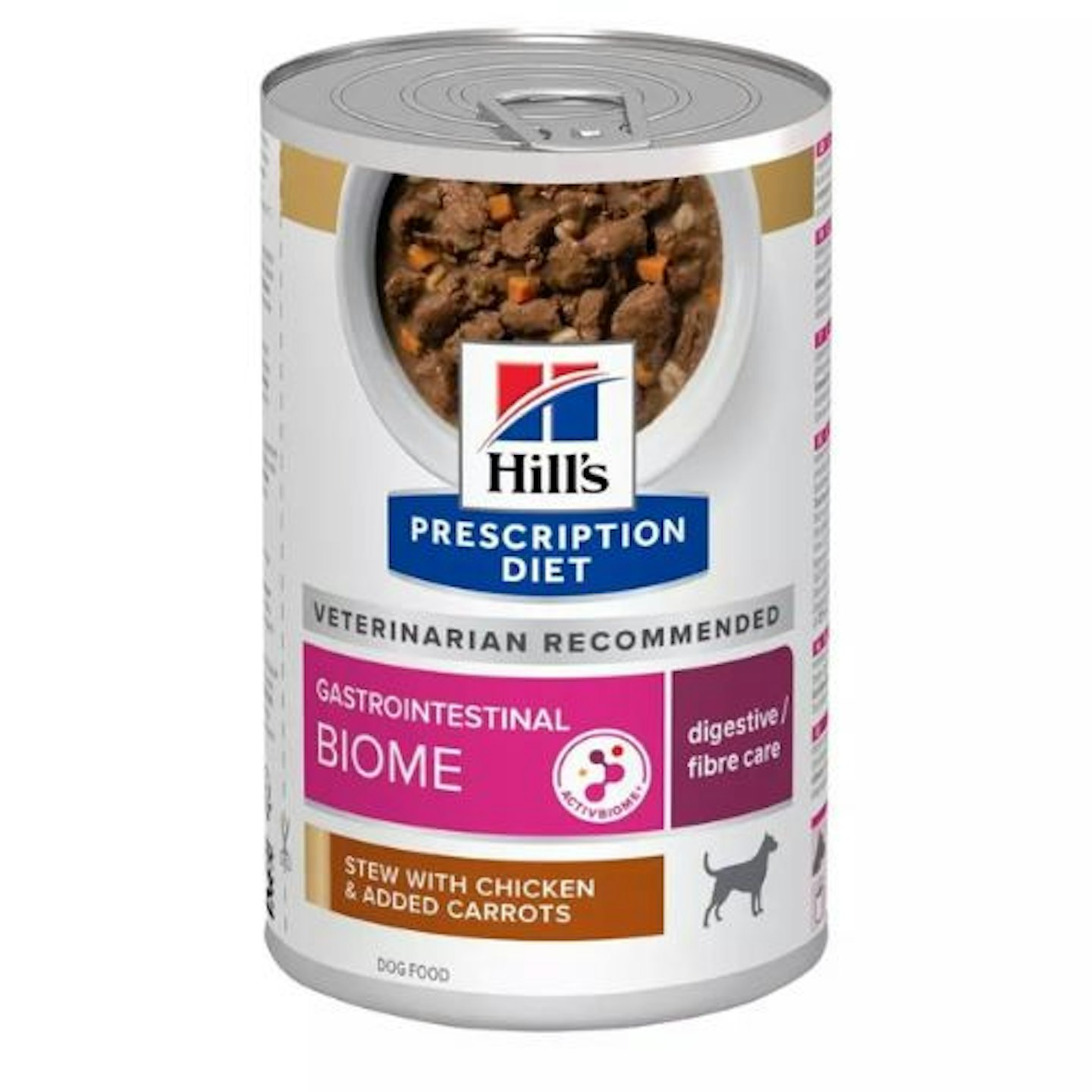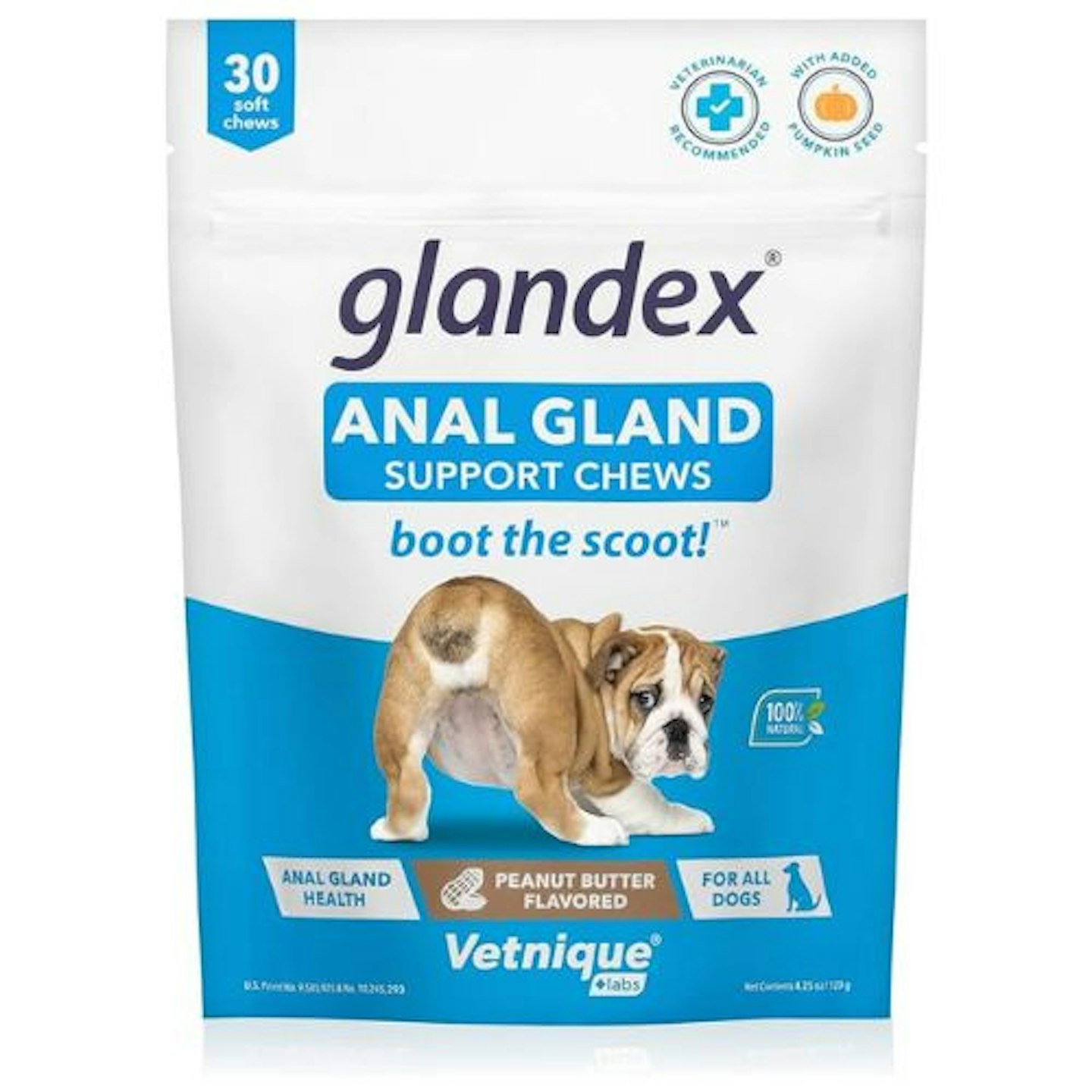When your furry friend has issues with their anal glands, it's not very nice for both you and your pooch, which is why we've rounded up the best high-fibre dog food to help with those anal gland problems. When a dog's anal glands become full, impacted or infected, it can be a smelly and disgusting problem. Not to mention uncomfortable for your dog. Changing their dog food to a diet with a higher fibre content and bran for dogs will help to firm up their stool. This will allow your pooch to naturally express their glands as they go to the toilet.
As a dog owner, you are probably familiar with anal glands. They are a pair of small sacs that sit just inside their bottom. They contain a strong-smelling liquid that is used by your pooch for marking their territory. Your dog should be able to empty them themselves as they pass a stool. However, now and again, they can get blocked. It's really important to make sure your dog's anal glands are regularly squeezed as it can cause a whole host of health problems. You can do this yourself or get your vet or groomers to do it for you. It's not a very pleasant job, though. The liquid inside the anal glands is quite thick and has a pungent, fishy smell and it can become quite messy. Ideally, you'll want your dog to express the glands themselves.
Best high-fibre dog food for anal gland problems at a glance:
• Best premium high-fibre food: Royal Canin Veterinary Health Gastrointestinal High Fibre Dry Adult Dog Food, 2kg - view on Viovet
• Best grain-free high-fibre food: Pooch & Mutt Gastrointestinal Dry Dog Food, 10kg - view on Pooch & Mutt
• Best high-fibre dog food for mini breeds: Hill’s Prescription Diet Gastrointestinal Biome Mini Dry Dog Food with Chicken, 1kg - view on Viovet
How do you know if your dog is experiencing anal gland problems? We put the question to resident Take A Break Vet, Dr Michael Lazaris. "You may notice your dog licking their back end, or the sides of their legs if they can’t reach their back end. Other dogs may scoot along the floor to help alleviate any itchiness or pain", says Dr Michael. "However, some dogs don’t show any signs of pain until infection sets in and they develop a nasty anal gland abscess." If you want to know more about how to help your dog showing signs of having anal gland problems, Dr Michael has answered some of the most frequently asked questions at the bottom of this article.
Changing your dog to a high-fibre wet or dry dog food diet can help with anal gland problems as it'll create a firming stool that will naturally squeeze the liquid out of the sacks as your dog passes it. In addition, it is possible to add fibre to a dog's diet with supplements. That's why we've searched the web for high-fibre dog food to help with anal gland problems so you can give your pooch a helping hand without you physically having to express them.
Best high fibre dog food for anal gland problems
Best premium high-fibre food
 Viovet/Royal Canin
Viovet/Royal Caninwww.viovet.co.uk
The Royal Canin Veterinary Health Gastrointestinal High Fibre Dry Adult Dog Food offers a diet rich in fibre that is specifically balanced to support healthy digestion and gastrointestinal transit. It contains prebiotics and nutrients that are easy for your dog to digest and will help your dog to maintain their energy levels. By regulating your dog's intestinal tract, this food can relieve constipation and help control diarrhoea, so it will definitely aid with stool formation.
Customer review: "My vets suggested this for my doxie after a lot of anal gland issues and I have to say this has really helped. We now no longer require going to be manually emptying his glands every 4-6 weeks and currently trying 12 weeks gaps to see if he can continue to empty himself which is a great relief as a dog parent."
Pros
- Contains a specific blend of fibres
- Help to support and regulate your dog's intestinal transit
Cons
- You will need to have somewhere to properly store the larger bags to stop the food from going stale
| Food type: | Dry food |
| Food weight: | 2kg, 7.5kg, 14kg |
Best grain-free high-fibre food
 Pooch & Mutt
Pooch & Muttwww.poochandmutt.co.uk
Part of Pooch & Mutt's vet-recommended dog food range, the Pooch + Mutt Gastrointestinal Dry Dog Food is high in fibre, containing dried apple pulp to aid with creating a more solid stool consistency, which will in turn help with emptying your pooch's anal glands. It's filled with high-protein herring and salmon to keep digestion flowing healthily and its recipe is made with a grain-free base, so ideal for those pups with a sensitive tum.
Pros
- Added probiotics and prebiotics to promote healthy gut flora
- Grain-free base
Cons
- Not designed to be fed to your pooch long-term, Pooch & Mutt recommend a maximum of 12 weeks
| Food type: | Dry food |
| Food weight: | 1.5kg, 10kg |
Best high-fibre dog food for mini breeds
 Hill’s Prescription Diet/Viovet
Hill’s Prescription Diet/Viovetwww.viovet.co.uk
Got a Yorkshire Terrier, Dachshund, Pug or any other mini breed that is having issues with their anal glands? This Hill’s Prescription Diet Gastrointestinal Biome Mini Dry Dog Food with Chicken should help to sort them out. With bite-size kibble made for their little mouths, it's clinically shown to help firm stools within 24 hours. It also will nourish and activate your pooch's cut microbiome to support digestive health and overall well-being.
Customer review: "My dog has indigestion problems where her poo can be very loose, but not with this product. It’s brilliant and she loves it."
Pros
- Has a unique blend of prebiotic fibres to promote regular bowel movements and help balance digestive function
- High levels of omega-3 fatty acids
Cons
- Not suitable for growing puppies, pregnant or nursing dogs or pooches with chronic kidney disease
| Food type: | Dry food |
| Food weight: | 1kg, 3kg |
Best high-fibre dog food for large breeds
 Hill's Prescription Diet/Viovet
Hill's Prescription Diet/Viovetwww.viovet.co.uk
Offering the same benefits as the food above but just for larger breeds is Hill's Prescription Diet Gastrointestinal Biome Dry Dog Food with Chicken. Containing nearly seven per cent of crude fibre, this rich diet will not only help with firming up your pooch's stool but also contains high levels of Omega three fatty acids, which have a range of benefits for dogs, including brain development, joint care and coat appearance.
Customer review: "It was recommended by my vet. I only got the small bag to try but was very pleased with the results, so have ordered the big bag now."
Pros
- Great for larger breeds
- Supports digestive health and wellbeing
Cons
- Not suitable for growing puppies, pregnant or nursing dogs or pooches with chronic kidney disease
| Food type: | Dry food |
| Food weight: | 1.5kg, 10kg |
Best high-fibre wet dog food
 Hill's Prescription Diet/Viovet
Hill's Prescription Diet/Viovetwww.viovet.co.uk
Is your dog more of a fan of wet food? The Hill's Prescription Diet Gastrointestinal Biome Wet Dog Food is sure to get tails wagging at mealtimes with its chicken and vegetable stew recipe. Just like the dry food we've included from Hill's, this wet food diet will firm up those stools and contains an active blend of fibres to nourish the gut and digestive system. It's enriched with psyllium to support their overall bowel health.
Customer review: "My dog with chronic colitis responded very well to this food."
Pros
- Made with ActivBiome+ ingredient to rapidly activate the gut microbiome
- Help with managing complex gastrointestinal issues
Cons
- Will need to make sure you've got space in your fridge to store a tin once opened, if you don't use it all at once, to keep it fresh
| Food type: | Wet food |
| Food weight: | 12 x 370g tins |
Best gastrointestinal food for firmer stools
 Purina/Amazon
Purina/AmazonA lower fibre option compared to some of the other foods on this list, but the Pro Plan Veterinary Diets Gastrointestinal Dry Dog Food is designed to help pooches manage intestinal disorders and will contribute to the formation of a healthy solid stool. The ingredients are easy to digest to help reduce gut workload and minimise non-absorbed nutrients. It also contains medium-chain fatty acids, which come together with prebiotics and soluble fibre, to promote a healthy intestinal environment.
Customer review: "This product did help with the anal glands with both my dogs. They both loved the flavour but most importantly it helped to clear the gland problem at that time"
Pros
- Easy-to-digest ingredients
- Low fat to facilitate digestion
Cons
- Not as much fibre compared to other diets
| Food type: | Dry food |
| Food weight: | 1.5kg, 5kg, 12kg |
7.
Tails.com
Best tailored high-fibre dog food
 Tails.com
Tails.comtails.com
Looking for a more tailored solution to help with your dog's anal gland problems? Food from Tails.com is made with the needs of your dog in mind. Most of the ingredients in their kibbles contain soluble and insoluble fibres, which will help with keeping dogs regular and bulking up stools while also slowing down your dog's digestion to encourage it to absorb all the good nutrients packed into the food.
Our review: "As Frankie is food driven, he'll eat almost anything, but it's clear that tails.com is on another level for him. Alaskan Malamutes are a vocal breed, so when they really love something, you'll know about it. Dinner time has now become an almighty song and dance. He leaps around the room, barking and howling at us until we're done dishing up, and he can dig in, wolfing it down in just a few minutes. He's never been this vocal about any previous food brands, so I know he loves it."
Want to know more about Tails.com food? Check out our Tails.com review.
Pros
- Tailored to your dog's exact needs
- Contains a balance of soluble and insoluble fibres
Cons
- Price varies by breed/size of dog
Best high fibre food supplements for dogs
If you're looking for a convenient way to add fibre to a dog's diet naturally, there are some brans for dogs in supplement form that can help.
Best vet recommended fibre supplements
 Glandex/Amazon
Glandex/AmazonGlandex Fibre Supplements support dog anal gland health with a patented formula including pumpkin seed, fibre blend, Omega Fatty Acids, digestive enzymes, prebiotics, and probiotics. Veterinarian-recommended, it guarantees results in 3-5 weeks, addressing scooting issues, and comes with a 100% satisfaction guarantee.
Customer review: "Before using these we were going to the vets on average every three weeks to get our puppy’s glands done. So far it’s been eight weeks with no sign of needing to go again."
Pros
- All-natural premium ingredients
- Effective
Cons
- Whilst, good, they didn't work on all dogs
Best gluten free fibre supplement
 PetExx/Amazon
PetExx/AmazonFibre Boost by PetExx combines oat bran, psyllium, amino acids, bentonite clay, L-Glutamine, beta-glucans, and E-Faecium for a healthy digestive system in dogs. It aids allergy relief, addresses anal gland issues, and ensures firm stools. The gluten-free powder requires a small daily dose, supporting gut balance without increased defecation. It helps dogs with constipation, colitis and irregular stools, and anal gland problems.
Customer review: "This product is much better than the fibre I’ve used before as my dog enjoys eating it more and it does the job as her anal glands haven’t needed to be emptied as frequently."
Pros
- Gluten-free
- Contains probiotics
Cons
- Fussy dogs may not like this
A high-fibre diet for anal gland problems isn't designed for long-term consumption so we'd recommend speaking to your vet before making the switch.
How we chose the best high fibre dog food for anal gland problems
All of these high-fibre dog foods for anal gland problems have been hand-selected by our team of Take A Break Pets shopping experts. We carefully considered the ingredients, weight and value in our selection of the best. Our team has spent hours investigating and researching to make it easier for you to find the very best, and we'd never recommend a product we don't believe in.
With pets big and small on our team, where possible we'll share the best products that have been tried and tested by our own furry friends who have given their paw of approval. And, with help from veterinary experts, we share their knowledge to ensure everything we choose is paw-fect for your pet.
We asked Dr Michael everything you need to know about anal gland problems, and how a high-fibre diet can help with the issue.
Best high-fibre dog food anal gland problems FAQs
Why do dogs have issues with their anal glands?
"Anal gland issues usually arise from ongoing soft faeces, which can be due to several different issues, such as low fibre, dietary allergies or intolerances, parasite or bacterial infections, and more serious diseases such as liver disease.
"Some dogs naturally produce more anal gland contents than others, which means they fill up faster. The contents also vary in consistency, with thick liquid being much harder to express than watery liquid. There are also very narrow ducts which connect the gland to the outside of the rectum. In some cases, these ducts become blocked or too narrow to allow the contents to move through. There is also a type of cancer which can arise from anal glands, which is why it is very important for a vet to check up on your pooch if they have repeated anal gland issues."
How can I help my dog express their anal glands naturally?
"If your pooch is showing signs of anal gland discomfort, I would first book them in at your vet clinic for anal gland expression. This way a vet or nurse can empty the glands efficiently and pick up on any underlying causes of the problem. This will also be very important if your dog has blocked anal glands due to ongoing diarrhoea, as this needs to be addressed quickly otherwise the glands will just keep filling up.
"At home, you can start by adding fibre to your pet’s food. There are high-fibre diets you can try which means you don’t need to add anything extra to their food bowl. Sometimes a simple switch to another brand of dog food can help, especially if there are underlying food allergies or intolerances involved."
How do high-fibre foods help a dog with anal gland issues?
"Dogs have two scent glands situated at their rectum, which are naturally expressed when a dog passes faeces. If a dog has poo which is constantly soft or runny, the glands are not compressed during defecation, so they cannot express. This leads to a build-up of anal gland contents, which can be irritating and painful, hence the bum-licking and scooting. It can even lead to nasty infections which require a vet’s intervention. Diets which contain good levels of fibre, or higher amounts, can help firm up the faeces, which naturally helps the glands express themselves."
What if my dog's anal gland problem doesn’t get better?
"In some cases, dogs, unfortunately, have ongoing anal gland issues and repeated infections, which means repeated vet visits, medication and money. If things like added fibre don’t help, your vet may want to flush out the glands under sedation or take a swab to culture the contents. In more serious cases, surgery may be needed, where the anal glands are completely removed. This solves the problem once and for all."
This article contains expert advice from Dr Michael Lazaris. Dr Michael is a small animal vet and co-director of his practice, Vets on the Common, in London. You can also find him on Instagram and TikTok, where he shares all the latest pet advice and adorable patients he treats.
Rosie Floyd is a Pets, Homes and Garden Product Writer for Take A Break Pets, specialising in all things dogs. She grew up always having at least one dog as part of the family and has experience in owning a variety of breeds, including Labradors, Cockapoos and Yorkshire Terriers.
